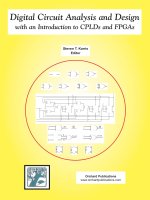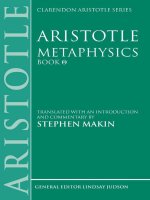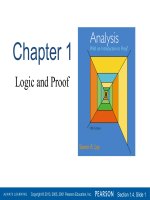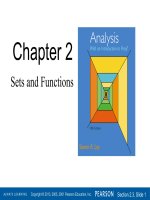C how to program with an introduction to c++ (paul deitel, harvey deitel)
Bạn đang xem bản rút gọn của tài liệu. Xem và tải ngay bản đầy đủ của tài liệu tại đây (5.42 MB, 1,006 trang )
HOW TO PROGRAM
EIGHTH EDITION
GLOBAL EDITION
with an introduction to C++
This page intentionally left blank
HOW TO PROGRAM
EIGHTH EDITION
GLOBAL EDITION
with an introduction to C++
Paul Deitel
Deitel & Associates, Inc.
Harvey Deitel
Deitel & Associates, Inc.
Global Edition contributions by
Piyali Sengupta
Boston Columbus Hoboken Indianapolis New York San Francisco
Amsterdam Cape Town Dubai London Madrid Milan Munich Paris Montreal
˜ Paulo Sydney Hong Kong Seoul Singapore Taipei Tokyo
Toronto Delhi Mexico City Sao
Vice President and Editorial Director, ECS: Marcia J. Horton
Executive Editor: Tracy Johnson (Dunkelberger)
Editorial Assistant: Kelsey Loanes
Assistant Acquisitions Editor, Global Editions: Aditee Agarwal
Program Manager: Carole Snyder
Project Manager: Robert Engelhardt
Project Editor, Global Editions: K.K. Neelakantan
Media Team Lead: Steve Wright
R&P Manager: Rachel Youdelman
R&P Senior Project Manager: William Opaluch
Senior Operations Specialist: Maura Zaldivar-Garcia
Senior Manufacturing Controller, Global Editions: Kay Holman
Inventory Manager: Bruce Boundy
Marketing Manager: Demetrius Hall
Product Marketing Manager: Bram Van Kempen
Media Production Manager, Global Editions: Vikram Kumar
Marketing Assistant: Jon Bryant
Cover Designer: Chuti Prasertsith / Michael Rutkowski / Marta Samsel
Cover Art: © Igoror / Shutterstock
Pearson Education Limited
Edinburgh Gate
Harlow
Essex CM20 2JE
England
and Associated Companies throughout the world
Visit us on the World Wide Web at:
www.pearsonglobaleditions.com
© Pearson Education Limited 2016
The rights of Paul Deitel and Harvey Deitel to be identified as the authors of this work have been asserted by them in
accordance with the Copyright, Designs and Patents Act 1988.
Authorized adaptation from the United States edition, entitled C How to Program: with an introduction to C++,8st edition,
ISBN 978-0-13-397689-2, by Paul Deitel and Harvey Deitel published by Pearson Education © 2016.
All rights reserved. No part of this publication may be reproduced, stored in a retrieval system, or transmitted in any
form or by any means, electronic, mechanical, photocopying, recording or otherwise, without either the prior written
permission of the publisher or a license permitting restricted copying in the United Kingdom issued by the Copyright
Licensing Agency Ltd, Saffron House, 6–10 Kirby Street, London EC1N 8TS.
All trademarks used herein are the property of their respective owners. The use of any trademark in this text does not
vest in the author or publisher any trademark ownership rights in such trademarks, nor does the use of such trademarks
imply any affiliation with or endorsement of this book by such owners.
British Library Cataloguing-in-Publication Data
A catalogue record for this book is available from the British Library
10 9 8 7 6 5 4 3 2 1
ISBN 10: 1-292-11097-X
ISBN 13: 978-1-292-11097-4
Typeset by GEX Publishing Services
Printed in Malaysia
In memory of Dennis Ritchie,
creator of the C programming language
and co-creator of the UNIX operating system.
Paul and Harvey Deitel
Trademarks
DEITEL, the double-thumbs-up bug and DIVE INTO are registered trademarks of Deitel and Associates,
Inc.
Apple, Xcode, Swift, Objective-C, iOS and OS X are trademarks or registered trademarks of Apple, Inc.
Java is a registered trademark of Oracle and/or its affiliates.
Microsoft and/or its respective suppliers make no representations about the suitability of the information
contained in the documents and related graphics published as part of the services for any purpose. All
such documents and related graphics are provided “as is” without warranty of any kind. Microsoft and/
or its respective suppliers hereby disclaim all warranties and conditions with regard to this information,
including all warranties and conditions of merchantability, whether express, implied or statutory, fitness
for a particular purpose, title and non-infringement. In no event shall Microsoft and/or its respective suppliers be liable for any special, indirect or consequential damages or any damages whatsoever resulting
from loss of use, data or profits, whether in an action of contract, negligence or other tortious action,
arising out of or in connection with the use or performance of information available from the services.
The documents and related graphics contained herein could include technical inaccuracies or typographical errors. Changes are periodically added to the information herein. Microsoft and/or its respective suppliers may make improvements and/or changes in the product(s) and/or the program(s) described herein
at any time. Partial screen shots may be viewed in full within the software version specified.
Other names may be trademarks of their respective owners.
Contents
Appendices F, G and H are PDF documents posted online at the book’s Companion
Website (located at www.pearsonglobaleditions.com/deitel).
Preface
1
1.1
1.2
1.3
1.4
1.5
1.6
1.7
1.8
1.9
1.10
Introduction to Computers, the Internet and
the Web
Introduction
Hardware and Software
1.2.1 Moore’s Law
1.2.2 Computer Organization
Data Hierarchy
Machine Languages, Assembly Languages and High-Level Languages
The C Programming Language
C Standard Library
C++ and Other C-Based Languages
Object Technology
1.8.1 The Automobile as an Object
1.8.2 Methods and Classes
1.8.3 Instantiation
1.8.4 Reuse
1.8.5 Messages and Method Calls
1.8.6 Attributes and Instance Variables
1.8.7 Encapsulation and Information Hiding
1.8.8 Inheritance
Typical C Program-Development Environment
1.9.1 Phase 1: Creating a Program
1.9.2 Phases 2 and 3: Preprocessing and Compiling a C Program
1.9.3 Phase 4: Linking
1.9.4 Phase 5: Loading
1.9.5 Phase 6: Execution
1.9.6 Problems That May Occur at Execution Time
1.9.7 Standard Input, Standard Output and Standard Error Streams
Test-Driving a C Application in Windows, Linux and Mac OS X
1.10.1 Running a C Application from the Windows Command Prompt
1.10.2 Running a C Application Using GNU C with Linux
23
33
34
35
35
36
37
40
41
42
43
44
45
45
45
45
46
46
46
46
47
48
48
48
49
49
49
49
49
50
53
8
Contents
1.13
1.14
1.10.3 Running a C Application Using the Teminal on Mac OS X
Operating Systems
1.11.1 Windows—A Proprietary Operating System
1.11.2 Linux—An Open-Source Operating System
1.11.3 Apple’s Mac OS X; Apple’s iOS for iPhone®, iPad® and
iPod Touch® Devices
1.11.4 Google’s Android
The Internet and World Wide Web
1.12.1 The Internet: A Network of Networks
1.12.2 The World Wide Web: Making the Internet User-Friendly
1.12.3 Web Services
1.12.4 Ajax
1.12.5 The Internet of Things
Some Key Software Terminology
Keeping Up-to-Date with Information Technologies
2
Introduction to C Programming
2.1
2.2
2.3
2.4
2.5
2.6
2.7
Introduction
A Simple C Program: Printing a Line of Text
Another Simple C Program: Adding Two Integers
Memory Concepts
Arithmetic in C
Decision Making: Equality and Relational Operators
Secure C Programming
3
Structured Program Development in C
3.1
3.2
3.3
3.4
3.5
3.6
3.7
3.8
3.9
3.11
3.12
3.13
Introduction
Algorithms
Pseudocode
Control Structures
The if Selection Statement
The if…else Selection Statement
The while Iteration Statement
Formulating Algorithms Case Study 1: Counter-Controlled Iteration
Formulating Algorithms with Top-Down, Stepwise Refinement
Case Study 2: Sentinel-Controlled Iteration
Formulating Algorithms with Top-Down, Stepwise Refinement
Case Study 3: Nested Control Statements
Assignment Operators
Increment and Decrement Operators
Secure C Programming
4
C Program Control
4.1
Introduction
1.11
1.12
3.10
56
59
59
59
60
60
61
61
61
62
64
64
64
66
71
72
72
76
80
81
85
89
101
102
102
102
103
105
106
110
111
114
120
124
125
127
145
146
Contents
4.2
4.3
4.4
4.5
4.6
4.7
4.8
4.9
4.10
4.11
4.12
4.13
Iteration Essentials
Counter-Controlled Iteration
for Iteration Statement
for Statement: Notes and Observations
Examples Using the for Statement
switch Multiple-Selection Statement
do…while Iteration Statement
break and continue Statements
Logical Operators
Confusing Equality (==) and Assignment (=) Operators
Structured Programming Summary
Secure C Programming
5
C Functions
5.1
5.2
5.3
5.4
5.5
5.6
5.7
5.8
5.9
5.10
5.11
5.12
5.13
5.14
5.15
5.16
5.17
Introduction
Modularizing Programs in C
Math Library Functions
Functions
Function Definitions
5.5.1 square Function
5.5.2 maximum Function
Function Prototypes: A Deeper Look
Function Call Stack and Stack Frames
Headers
Passing Arguments By Value and By Reference
Random Number Generation
Example: A Game of Chance; Introducing enum
Storage Classes
Scope Rules
Recursion
Example Using Recursion: Fibonacci Series
Recursion vs. Iteration
Secure C Programming
6
C Arrays
6.1
6.2
6.3
6.4
Introduction
Arrays
Defining Arrays
Array Examples
6.4.1 Defining an Array and Using a Loop to Set the Array’s
Element Values
6.4.2 Initializing an Array in a Definition with an Initializer List
6.4.3 Specifying an Array’s Size with a Symbolic Constant and
Initializing Array Elements with Calculations
9
146
147
148
151
152
155
161
162
164
167
169
174
189
190
190
191
193
193
194
197
198
200
204
205
206
210
214
216
219
222
226
227
246
247
247
249
249
249
250
252
10
Contents
6.4.4
6.4.5
6.4.6
6.4.7
6.12
6.13
Summing the Elements of an Array
Using Arrays to Summarize Survey Results
Graphing Array Element Values with Histograms
Rolling a Die 60,000,000 Times and Summarizing the Results
in an Array
Using Character Arrays to Store and Manipulate Strings
6.5.1 Initializing a Character Array with a String
6.5.2 Initializing a Character Array with an Intializer List of Characters
6.5.3 Accessing the Characters in a String
6.5.4 Inputting into a Character Array
6.5.5 Outputting a Character Array That Represents a String
6.5.6 Demonstrating Character Arrays
Static Local Arrays and Automatic Local Arrays
Passing Arrays to Functions
Sorting Arrays
Case Study: Computing Mean, Median and Mode Using Arrays
Searching Arrays
6.10.1 Searching an Array with Linear Search
6.10.2 Searching an Array with Binary Search
Multidimensional Arrays
6.11.1 Illustrating a Double-Subcripted Array
6.11.2 Initializing a Double-Subcripted Array
6.11.3 Setting the Elements in One Row
6.11.4 Totaling the Elements in a Two-Dimensional Array
6.11.5 Two-Dimensonal Array Manipulations
Variable-Length Arrays
Secure C Programming
7
C Pointers
7.1
7.2
7.3
7.4
7.5
Introduction
Pointer Variable Definitions and Initialization
Pointer Operators
Passing Arguments to Functions by Reference
Using the const Qualifier with Pointers
7.5.1 Converting a String to Uppercase Using a Non-Constant Pointer
to Non-Constant Data
7.5.2 Printing a String One Character at a Time Using a Non-Constant
Pointer to Constant Data
7.5.3 Attempting to Modify a Constant Pointer to Non-Constant Data
7.5.4 Attempting to Modify a Constant Pointer to Constant Data
Bubble Sort Using Pass-by-Reference
sizeof Operator
Pointer Expressions and Pointer Arithmetic
7.8.1 Allowed Operators for Pointer Arithmetic
7.8.2 Aiming a Pointer at an Array
6.5
6.6
6.7
6.8
6.9
6.10
6.11
7.6
7.7
7.8
253
254
256
257
257
258
258
258
258
259
259
260
262
266
268
273
273
274
278
278
279
281
281
282
285
288
306
307
308
309
311
315
316
317
319
320
321
324
327
327
327
Contents
7.13
7.8.3 Adding an Integer to a Pointer
7.8.4 Subtracting an Integer from a Pointer
7.8.5 Incrementing and Decrementing a Pointer
7.8.6 Subtracting One Pointer from Another
7.8.7 Assigning Pointers to One Another
7.8.8 Pointer to void
7.8.9 Comparing Pointers
Relationship between Pointers and Arrays
7.9.1 Pointer/Offset Notation
7.9.2 Pointer/Index Notation
7.9.3 Cannot Modify an Array Name with Pointer Arithmetic
7.9.4 Demonstrating Pointer Indexing and Offsets
7.9.5 String Copying with Arrays and Pointers
Arrays of Pointers
Case Study: Card Shuffling and Dealing Simulation
Pointers to Functions
7.12.1 Sorting in Ascending or Descending Order
7.12.2 Using Function Pointers to Create a Menu-Driven System
Secure C Programming
8
C Characters and Strings
8.1
8.2
8.3
Introduction
Fundamentals of Strings and Characters
Character-Handling Library
8.3.1 Functions isdigit, isalpha, isalnum and isxdigit
8.3.2 Functions islower, isupper, tolower and toupper
8.3.3 Functions isspace, iscntrl, ispunct, isprint and isgraph
String-Conversion Functions
8.4.1 Function strtod
8.4.2 Function strtol
8.4.3 Function strtoul
Standard Input/Output Library Functions
8.5.1 Functions fgets and putchar
8.5.2 Function getchar
8.5.3 Function sprintf
8.5.4 Function sscanf
String-Manipulation Functions of the String-Handling Library
8.6.1 Functions strcpy and strncpy
8.6.2 Functions strcat and strncat
Comparison Functions of the String-Handling Library
Search Functions of the String-Handling Library
8.8.1 Function strchr
8.8.2 Function strcspn
8.8.3 Function strpbrk
8.8.4 Function strrchr
7.9
7.10
7.11
7.12
8.4
8.5
8.6
8.7
8.8
11
328
328
328
329
329
329
329
330
330
331
331
331
332
334
335
340
340
343
345
365
366
366
368
368
371
372
374
374
375
376
376
377
378
379
380
381
382
382
383
385
386
387
387
388
12
Contents
8.11
8.8.5 Function strspn
8.8.6 Function strstr
8.8.7 Function strtok
Memory Functions of the String-Handling Library
8.9.1 Function memcpy
8.9.2 Function memmove
8.9.3 Function memcmp
8.9.4 Function memchr
8.9.5 Function memset
Other Functions of the String-Handling Library
8.10.1 Function strerror
8.10.2 Function strlen
Secure C Programming
9
C Formatted Input/Output
9.1
9.2
9.3
9.4
9.5
Introduction
Streams
Formatting Output with printf
Printing Integers
Printing Floating-Point Numbers
9.5.1 Conversion Specifiers e, E and f
9.5.2 Conversion Specifiers g and G
9.5.3 Demonstrating Floating-Point Conversion Specifiers
Printing Strings and Characters
Other Conversion Specifiers
Printing with Field Widths and Precision
9.8.1 Specifying Field Widths for Printing Integers
9.8.2 Specifying Precisions for Integers, Floating-Point Numbers
and Strings
9.8.3 Combining Field Widths and Precisions
Using Flags in the printf Format Control String
9.9.1 Right and Left Justification
9.9.2 Printing Positive and Negative Numbers with and without
the + Flag
9.9.3 Using the Space Flag
9.9.4 Using the # Flag
9.9.5 Using the 0 Flag
Printing Literals and Escape Sequences
Reading Formatted Input with scanf
9.11.1 scanf Syntax
9.11.2 scanf Conversion Specifiers
9.11.3 Reading Integers with scanf
9.11.4 Reading Floating-Point Numbers with scanf
9.11.5 Reading Characters and Strings with scanf
9.11.6 Using Scan Sets with scanf
8.9
8.10
9.6
9.7
9.8
9.9
9.10
9.11
389
389
390
391
392
393
394
394
395
395
396
396
397
409
410
410
410
411
412
413
413
414
414
415
416
416
417
418
419
419
420
420
421
421
422
422
423
423
424
425
425
426
Contents
9.12
10
10.1
10.2
10.3
10.4
10.5
10.6
10.7
10.8
9.11.7 Using Field Widths with scanf
9.11.8 Skipping Characters in an Input Stream
Secure C Programming
C Structures, Unions, Bit Manipulation and
Enumerations
Introduction
Structure Definitions
10.2.1 Self-Referential Structures
10.2.2 Defining Variables of Structure Types
10.2.3 Structure Tag Names
10.2.4 Operations That Can Be Performed on Structures
Initializing Structures
Accessing Structure Members with . and ->
Using Structures with Functions
typedef
10.11
10.12
10.13
Example: High-Performance Card Shuffling and Dealing Simulation
Unions
10.8.1 Union Declarations
10.8.2 Operations That Can Be Performed on Unions
10.8.3 Initializing Unions in Declarations
10.8.4 Demonstrating Unions
Bitwise Operators
10.9.1 Displaying an Unsigned Integer in Bits
10.9.2 Making Function displayBits More Generic and Portable
10.9.3 Using the Bitwise AND, Inclusive OR, Exclusive OR and
Complement Operators
10.9.4 Using the Bitwise Left- and Right-Shift Operators
10.9.5 Bitwise Assignment Operators
Bit Fields
10.10.1 Defining Bit Fields
10.10.2 Using Bit Fields to Represent a Card’s Face, Suit and Color
10.10.3 Unnamed Bit Fields
Enumeration Constants
Anonymous Structures and Unions
Secure C Programming
11
C File Processing
11.1
11.2
11.3
Introduction
Files and Streams
Creating a Sequential-Access File
11.3.1 Pointer to a FILE
11.3.2 Using fopen to Open the File
11.3.3 Using feof to Check for the End-of-File Indicator
10.9
10.10
13
427
428
429
436
437
437
438
439
439
439
440
440
442
443
443
446
446
447
447
447
448
449
451
452
455
456
457
457
458
460
460
462
462
473
474
474
475
477
477
477
14
Contents
11.3.4 Using fprintf to Write to the File
11.3.5 Using fclose to Close the File
11.3.6 File Open Modes
11.4 Reading Data from a Sequential-Access File
11.4.1 Resetting the File Position Pointer
11.4.2 Credit Inquiry Program
11.5 Random-Access Files
11.6 Creating a Random-Access File
11.7 Writing Data Randomly to a Random-Access File
11.7.1 Positioning the File Position Pointer with fseek
11.7.2 Error Checking
11.8 Reading Data from a Random-Access File
11.9 Case Study: Transaction-Processing Program
11.10 Secure C Programming
12
C Data Structures
12.1
12.2
12.3
12.4
12.8
Introduction
Self-Referential Structures
Dynamic Memory Allocation
Linked Lists
12.4.1 Function insert
12.4.2 Function delete
12.4.3 Function printList
Stacks
12.5.1 Function push
12.5.2 Function pop
12.5.3 Applications of Stacks
Queues
12.6.1 Function enqueue
12.6.2 Function dequeue
Trees
12.7.1 Function insertNode
12.7.2 Traversals: Functions inOrder, preOrder and postOrder
12.7.3 Duplicate Elimination
12.7.4 Binary Tree Search
12.7.5 Other Binary Tree Operations
Secure C Programming
13
C Preprocessor
13.1
13.2
13.3
13.4
Introduction
#include Preprocessor Directive
#define Preprocessor Directive: Symbolic Constants
#define Preprocessor Directive: Macros
13.4.1 Macro with One Argument
12.5
12.6
12.7
478
478
479
481
482
482
486
486
488
490
491
491
493
498
509
510
511
511
512
518
519
521
521
525
526
526
527
531
532
533
536
537
538
538
538
538
550
551
551
552
553
553
Contents
13.4.2 Macro with Two Arguments
13.4.3 Macro Continuation Character
13.4.4 #undef Preprocessor Directive
13.4.5 Standard Library Functions and Macros
13.4.6 Do Not Place Expressions with Side Effects in Macros
13.5 Conditional Compilation
13.5.1 #if…#endif Preprocessor Directive
13.5.2 Commenting Out Blocks of Code with #if…#endif
13.5.3 Conditionally Compiling Debugging Code
13.6 #error and #pragma Preprocessor Directives
13.7 # and ## Operators
13.8 Line Numbers
13.9 Predefined Symbolic Constants
13.10 Assertions
13.11 Secure C Programming
14
Other C Topics
14.1
14.2
Introduction
Redirecting I/O
14.2.1 Redirecting Input with <
14.2.2 Redirecting Input with |
14.2.3 Redirecting Output
14.3 Variable-Length Argument Lists
14.4 Using Command-Line Arguments
14.5 Compiling Multiple-Source-File Programs
14.5.1 extern Declarations for Global Variables in Other Files
14.5.2 Function Prototypes
14.5.3 Restricting Scope with static
14.5.4 Makefiles
14.6 Program Termination with exit and atexit
14.7 Suffixes for Integer and Floating-Point Literals
14.8 Signal Handling
14.9 Dynamic Memory Allocation: Functions calloc and realloc
14.10 Unconditional Branching with goto
15
C++ as a Better C; Introducing Object
Technology
15.1
15.2
15.3
Introduction
C++
A Simple Program: Adding Two Integers
15.3.1 Addition Program in C++
15.3.2 <iostream> Header
15.3.3 main Function
15.3.4 Variable Declarations
15
554
554
554
554
555
555
555
555
556
556
556
557
557
558
558
563
564
564
564
565
565
565
567
569
569
569
570
570
570
572
572
575
575
581
582
582
583
583
584
584
584
16
Contents
15.16
15.3.5 Standard Output Stream and Standard Input Stream Objects
15.3.6 std::endl Stream Manipulator
15.3.7 std:: Explained
15.3.8 Concatenated Stream Outputs
15.3.9 return Statement Not Required in main
15.3.10 Operator Overloading
C++ Standard Library
Header Files
Inline Functions
C++ Keywords
References and Reference Parameters
15.8.1 Reference Parameters
15.8.2 Passing Arguments by Value and by Reference
15.8.3 References as Aliases within a Function
15.8.4 Returning a Reference from a Function
15.8.5 Error Messages for Uninitialized References
Empty Parameter Lists
Default Arguments
Unary Scope Resolution Operator
Function Overloading
Function Templates
15.13.1 Defining a Function Template
15.13.2 Using a Function Template
Introduction to Object Technology and the UML
15.14.1 Basic Object Technology Concepts
15.14.2 Classes, Data Members and Member Functions
15.14.3 Object-Oriented Analysis and Design
15.14.4 The Unified Modeling Language
Introduction to C++ Standard Library Class Template vector
15.15.1 Problems Associated with C-Style Pointer-Based Arrays
15.15.2 Using Class Template vector
15.15.3 Exception Handling: Processing an Out-of-Range Index
Wrap-Up
16
Introduction to Classes, Objects and Strings
16.1
16.2
16.3
16.4
16.5
16.6
16.7
16.8
16.9
Introduction
Defining a Class with a Member Function
Defining a Member Function with a Parameter
Data Members, set Member Functions and get Member Functions
Initializing Objects with Constructors
Placing a Class in a Separate File for Reusability
Separating Interface from Implementation
Validating Data with set Functions
Wrap-Up
15.4
15.5
15.6
15.7
15.8
15.9
15.10
15.11
15.12
15.13
15.14
15.15
584
585
585
585
585
585
586
586
588
590
591
591
592
594
595
596
596
596
598
599
602
602
603
605
605
606
607
608
608
608
609
613
615
621
622
622
625
629
634
638
642
647
652
Contents
17
17
Classes: A Deeper Look; Throwing Exceptions 659
17.1
17.2
17.3
17.4
17.5
17.6
17.7
17.8
17.9
17.10
17.11
17.12
17.13
17.14
17.15
Introduction
Time Class Case Study
Class Scope and Accessing Class Members
Access Functions and Utility Functions
Time Class Case Study: Constructors with Default Arguments
Destructors
When Constructors and Destructors Are Called
Time Class Case Study: A Subtle Trap—Returning a Reference or a
Pointer to a private Data Member
Default Memberwise Assignment
const Objects and const Member Functions
Composition: Objects as Members of Classes
friend Functions and friend Classes
Using the this Pointer
static Class Members
Wrap-Up
18
Operator Overloading; Class string
18.1
18.2
18.3
18.4
18.5
18.6
18.7
18.8
18.9
18.10
18.11
18.12
18.13
18.14
18.15
Introduction
Using the Overloaded Operators of Standard Library Class string
Fundamentals of Operator Overloading
Overloading Binary Operators
Overloading the Binary Stream Insertion and Stream Extraction Operators
Overloading Unary Operators
Overloading the Unary Prefix and Postfix ++ and -- Operators
Case Study: A Date Class
Dynamic Memory Management
Case Study: Array Class
18.10.1 Using the Array Class
18.10.2 Array Class Definition
Operators as Member vs. Non-Member Functions
Converting Between Types
explicit Constructors and Conversion Operators
Overloading the Function Call Operator ()
Wrap-Up
19
Object-Oriented Programming: Inheritance
19.1
19.2
19.3
Introduction
Base Classes and Derived Classes
Relationship between Base and Derived Classes
19.3.1 Creating and Using a CommissionEmployee Class
19.3.2 Creating a BasePlusCommissionEmployee Class Without
Using Inheritance
660
661
667
668
669
675
675
679
682
684
686
692
694
700
705
715
716
717
720
721
722
726
727
728
733
735
736
740
748
748
750
752
753
764
765
765
768
768
773
18
Contents
19.4
19.5
19.6
19.7
19.3.3 Creating a CommissionEmployee–BasePlusCommissionEmployee
Inheritance Hierarchy
19.3.4 CommissionEmployee–BasePlusCommissionEmployee Inheritance
Hierarchy Using protected Data
19.3.5 CommissionEmployee–BasePlusCommissionEmployee Inheritance
Hierarchy Using private Data
Constructors and Destructors in Derived Classes
public, protected and private Inheritance
Software Engineering with Inheritance
Wrap-Up
20
Object-Oriented Programming: Polymorphism 799
20.1
20.2
20.3
Introduction
Introduction to Polymorphism: Polymorphic Video Game
Relationships Among Objects in an Inheritance Hierarchy
20.3.1 Invoking Base-Class Functions from Derived-Class Objects
20.3.2 Aiming Derived-Class Pointers at Base-Class Objects
20.3.3 Derived-Class Member-Function Calls via Base-Class Pointers
20.3.4 Virtual Functions and Virtual Destructors
Type Fields and switch Statements
Abstract Classes and Pure virtual Functions
Case Study: Payroll System Using Polymorphism
20.6.1 Creating Abstract Base Class Employee
20.6.2 Creating Concrete Derived Class SalariedEmployee
20.6.3 Creating Concrete Derived Class CommissionEmployee
20.6.4 Creating Indirect Concrete Derived Class
20.4
20.5
20.6
BasePlusCommissionEmployee
20.9
20.6.5 Demonstrating Polymorphic Processing
(Optional) Polymorphism, Virtual Functions and Dynamic Binding
“Under the Hood”
Case Study: Payroll System Using Polymorphism and Runtime Type
Information with Downcasting, dynamic_cast, typeid and type_info
Wrap-Up
21
Stream Input/Output: A Deeper Look
21.1
21.2
Introduction
Streams
21.2.1 Classic Streams vs. Standard Streams
21.2.2 iostream Library Headers
21.2.3 Stream Input/Output Classes and Objects
Stream Output
21.3.1 Output of char * Variables
21.3.2 Character Output Using Member Function put
Stream Input
21.4.1 get and getline Member Functions
20.7
20.8
21.3
21.4
779
783
786
791
793
794
794
800
801
801
802
805
806
808
815
815
817
818
822
824
826
828
832
835
839
844
845
846
846
847
847
849
850
850
851
851
Contents
21.4.2 istream Member Functions peek, putback and ignore
21.4.3 Type-Safe I/O
21.5 Unformatted I/O Using read, write and gcount
21.6 Introduction to Stream Manipulators
21.6.1 Integral Stream Base: dec, oct, hex and setbase
21.6.2 Floating-Point Precision (precision, setprecision)
21.6.3 Field Width (width, setw)
21.6.4 User-Defined Output Stream Manipulators
21.7 Stream Format States and Stream Manipulators
21.7.1 Trailing Zeros and Decimal Points (showpoint)
21.7.2 Justification (left, right and internal)
21.7.3 Padding (fill, setfill)
21.7.4 Integral Stream Base (dec, oct, hex, showbase)
21.7.5 Floating-Point Numbers; Scientific and Fixed Notation
(scientific, fixed)
21.7.6 Uppercase/Lowercase Control (uppercase)
21.7.7 Specifying Boolean Format (boolalpha)
21.7.8 Setting and Resetting the Format State via Member F
unction flags
21.8 Stream Error States
21.9 Tying an Output Stream to an Input Stream
21.10 Wrap-Up
22
Exception Handling: A Deeper Look
22.1
22.2
22.3
22.4
22.5
22.6
22.7
22.8
22.9
22.10
22.11
Introduction
Example: Handling an Attempt to Divide by Zero
Rethrowing an Exception
Stack Unwinding
When to Use Exception Handling
Constructors, Destructors and Exception Handling
Exceptions and Inheritance
Processing new Failures
Class unique_ptr and Dynamic Memory Allocation
Standard Library Exception Hierarchy
Wrap-Up
23
Introduction to Custom Templates
23.1
23.2
23.3
23.4
23.5
23.6
23.7
Introduction
Class Templates
Function Template to Manipulate a Class-Template Specialization Object
Nontype Parameters
Default Arguments for Template Type Parameters
Overloading Function Templates
Wrap-Up
19
854
854
854
855
856
856
858
859
860
861
862
864
865
866
867
867
868
869
872
872
881
882
882
888
889
891
892
893
893
896
899
900
906
907
907
912
914
914
915
915
20
Contents
A
C and C++ Operator Precedence Charts
918
B
ASCII Character Set
922
C
Number Systems
923
C.1
C.2
C.3
C.4
C.5
C.6
Introduction
Abbreviating Binary Numbers as Octal and Hexadecimal Numbers
Converting Octal and Hexadecimal Numbers to Binary Numbers
Converting from Binary, Octal or Hexadecimal to Decimal
Converting from Decimal to Binary, Octal or Hexadecimal
Negative Binary Numbers: Two’s Complement Notation
D
Sorting: A Deeper Look
D.1
D.2
D.3
D.4
D.5
Introduction
Big O Notation
Selection Sort
Insertion Sort
Merge Sort
E
Multithreading and Other C11 and C99 Topics 956
E.1
E.2
E.3
E.4
E.5
E.6
E.7
E.8
Introduction
New C99 Headers
Designated Initializers and Compound Literals
Type bool
Implicit int in Function Declarations
Complex Numbers
Additions to the Preprocessor
Other C99 Features
E.8.1 Compiler Minimum Resource Limits
E.8.2 The restrict Keyword
E.8.3 Reliable Integer Division
E.8.4 Flexible Array Members
E.8.5 Relaxed Constraints on Aggregate Initialization
E.8.6 Type Generic Math
E.8.7 Inline Functions
E.8.8 Return Without Expression
E.8.9 __func__ Predefined Identifier
E.8.10 va_copy Macro
New Features in the C11 Standard
E.9.1 New C11 Headers
E.9.2 Multithreading Support
E.9.3 quick_exit function
E.9
924
927
928
928
929
931
936
937
937
938
942
945
957
958
959
961
963
964
965
966
966
967
967
967
968
968
968
969
969
969
969
970
970
978
Contents
E.9.4 Unicode® Support
E.9.5 _Noreturn Function Specifier
E.9.6 Type-Generic Expressions
E.9.7 Annex L: Analyzability and Undefined Behavior
E.9.8 Memory Alignment Control
E.9.9 Static Assertions
E.9.10 Floating-Point Types
E.10 Web Resources
21
978
978
978
979
979
979
980
980
Appendices on the Web
983
Index
984
Appendices F, G and H are PDF documents posted online at the book’s Companion
Website (located at www.pearsonglobaleditions.com/deitel).
F
Using the Visual Studio Debugger
G
Using the GNU gdb Debugger
H
Using the Xcode Debugger
This page intentionally left blank
Preface
Welcome to the C programming language and to C How to Program, Eighth Edition! This
book presents leading-edge computing technologies for college students, instructors and
software-development professionals.
At the heart of the book is the Deitel signature “live-code approach”—we present concepts in the context of complete working programs, rather than in code snippets. Each
code example is followed by one or more sample executions. Read the online Before You
Begin section at
/>
to learn how to set up your computer to run the hundreds of code examples. All the source
code is available at
www.pearsonglobaleditions.com/deitel
Use the source code we provide to run every program as you study it.
We believe that this book and its support materials will give you an informative, challenging and entertaining introduction to C. As you read the book, if you have questions,
send an e-mail to —we’ll respond promptly. For book updates, visit
www.deitel.com/books/chtp8/, join our social media communities:
ã
Facebookđ />
ã
Twitterđ@deitel
ã
LinkedInđ />
ã
YouTube />
ã
Google+ />
and register for the Deitel đ Buzz Online e-mail newsletter at:
/>
New and Updated Features
Here are some key features of C How to Program, 8/e:
•
Integrated More Capabilities of the C11 and C99 standards. Support for the C11
and C99 standards varies by compiler. Microsoft Visual C++ supports a subset of
the features that were added to C in C99 and C11—primarily the features that
are also required by the C++ standard. We incorporated several widely supported
C11 and C99 features into the book’s early chapters, as appropriate for introduc-
24
Preface
tory courses and for the compilers we used in this book. Appendix E, Multithreading and Other C11 and C99 Topics, presents more advanced features
(such as multithreading for today’s increasingly popular multi-core architectures)
and various other features that are not widely supported by today’s C compilers.
•
All Code Tested on Linux, Windows and OS X. We retested all the example and
exercise code using GNU gcc on Linux, Visual C++ on Windows (in Visual Studio 2013 Community Edition) and LLVM in Xcode on OS X.
•
Updated Chapter 1. The new Chapter 1 engages students with updated intriguing facts and figures to get them excited about studying computers and computer
programming. The chapter includes current technology trends and hardware discussions, the data hierarchy, social networking and a table of business and technology publications and websites that will help you stay up to date with the latest
technology news and trends. We’ve included updated test-drives that show how
to run a command-line C program on Linux, Microsoft Windows and OS X. We
also updated the discussions of the Internet and web, and the introduction to object technology.
•
Updated Coverage of C++ and Object-Oriented Programming. We updated
Chapters 15–23 on object-oriented programming in C++ with material from our
textbook C++ How to Program, 9/e, which is up-to-date with the C++11 standard.
•
Updated Code Style. We removed the spacing inside parentheses and square
brackets, and toned down our use of comments a bit. We also added parentheses
to certain compound conditions for clarity.
•
Variable Declarations. Because of improved compiler support, we were able to
move variable declarations closer to where they’re first used and define for-loop
counter-control variables in each for’s initialization section.
•
Summary Bullets. We removed the end-of-chapter terminology lists and updated
the detailed section-by-section, bullet-list summaries with bolded key terms and,
for most, page references to their defining occurrences.
•
Use of Standard Terminology. To help students prepare to work in industry
worldwide, we audited the book against the C standard and upgraded our terminology to use C standard terms in preference to general programming terms.
•
Online Debugger Appendices. We’ve updated the online GNU gdb and Visual
C++® debugging appendices, and added an Xcodeđ debugging appendix.
ã
Additional Exercises. We updated various exercises and added some new ones,
including one for the Fisher-Yates unbiased shuffling algorithm in Chapter 10.
Other Features
Other features of C How to Program, 8/e include:
•
Secure C Programming Sections. Many of the C chapters end with a Secure C
Programming Section. We’ve also posted a Secure C Programming Resource
Center at www.deitel.com/SecureC/. For more details, see the section “A Note
About Secure C Programming” on the next page.









